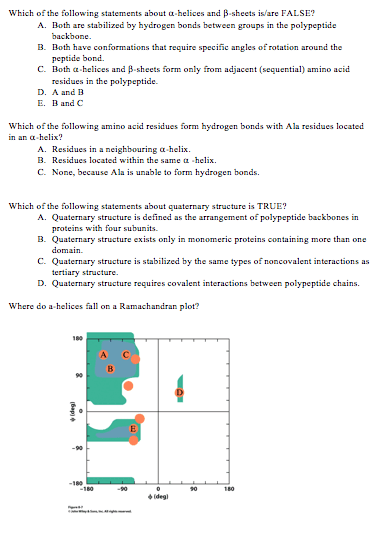BCHM-3050 Lecture Notes - Lecture 2: Surface Tension, Electric Field, Coordination Complex

Chapter 2: The Chemical Foundation of Life
The Importance of Noncovalent Interactions in Biochemistry
The linear sequence of the nucleotide residues in a strand of DNA is maintained by covalent bonds
(double helix), and is stabilized by noncovalent interactions between different parts of the molecule.
oProteins are made up of amino acids which are linked by covalent peptide bonds, and is folded
into a specific molecular configuration that is stabilized by numerous noncovalent interactions.
Interact with other protein molecules or DNA to form higher levels of organization
(tertiary, quaternary, etc.)
Covalent bond energies = 150-400 kJ/mol and noncovalent bonds are 10-100 times weaker.
oThe weakness allows them to be continually broken and re-formed in the molecular interactions
of life.
oEnergy is sufficient to provide stability to macromolecular structures like DNA, proteins, and
membranes.
The Nature of Noncovalent Interactions
All the noncovalent interactions are electrostatic in nature (depend on the forces that electrical charges
exert on one another.
Charge-Charge Interactions (ionic bonds/salt bridges) – the simplest noncovalent interaction is the
electrostatic interaction between a pair of ions.
oThe cell contains a lot of small ions like Na+ , K+ (cations), Mg2+ , and Cl- (anion). All of these
exert forces on one another, and can be separated in a vacuum via Coulomb’s Law
oThe existence of the medium between charges has the effect of screening them from one
another, so that the actual force between two charges is always less than the equation given. The
screening is expressed by inserting an electrostatic constant
oCoulomb’s Law is an expression of force, and every bond formation or cleavage process
involves a change in energy.
Energy of Interaction (E) – energy that is required to separate two charged particles
from a distance to a distance to pull them apart by countering the attractive
electrostatic force between them.
oCharge-charge interactions are important in determining the binding specificity between
proteins and their binding targets.
Dipole and Induced Dipole Interactions
oMolecules that carry no net charge may have an asymmetric internal distribution of charge.
oA dipole moment expresses the magnitude of a molecule’s polarity.
Water has a significant dipole moment because electrons are drawn from the
hydrogen atoms toward the oxygen atom, due to the much greater electronegativity
of the oxygen atom.
Molecules with large dipole moments are said to be polar
oIn an aqueous environment, a polar molecule can be attracted by a nearby ion (charge-dipole
interaction) or by another polar molecule (dipole-dipole interaction).
find more resources at oneclass.com
find more resources at oneclass.com
Document Summary
Interact with other protein molecules or dna to form higher levels of organization (tertiary, quaternary, etc. ) All the noncovalent interactions are electrostatic in nature (depend on the forces that electrical charges exert on one another. Charge-charge interactions (ionic bonds/salt bridges) the simplest noncovalent interaction is the electrostatic interaction between a pair of ions: the cell contains a lot of small ions like na+ , k+ (cations), mg2+ , and cl- (anion). The screening is expressed by inserting an electrostatic constant: coulomb"s law is an expression of force, and every bond formation or cleavage process involves a change in energy. Dipole and induced dipole interactions: molecules that carry no net charge may have an asymmetric internal distribution of charge, a dipole moment expresses the magnitude of a molecule"s polarity. Water has a significant dipole moment because electrons are drawn from the hydrogen atoms toward the oxygen atom, due to the much greater electronegativity of the oxygen atom.



